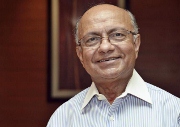
Former Assistant Secretary-General of the United Nations Kul Gautam says interfaith collaboration can work wonders for uplifting the lives of children.
Kul Gautam is Chair of the Council of the World Day of Prayer and Action for Children (DPAC). He was formerly Deputy Executive Director of UNICEF. In Coimbatore with DPAC’s council to participate in Shanti Ashram’s Interfaith Round Table 2013, Kul shares his thoughts on the role religion can play to help children.
What is the World Day of Prayer and Action for Children and why does it work for children by networking with worldwide religious organisations in particular? what inspired its model?
November 20 is Universal Children’s Day and everybody celebrates it differently — doctors through health initiative and teachers through schools — but many religious organisations wanted to know how exactly they could contribute. Since all religions prioritise prayer, we suggested that they spend the day in prayer for children and take those prayers forward through action. That’s how, in 2009 after a meeting in Hiroshima, November 20 also became the DPAC.
Religious organisations can initiate much change because they influence society’s behaviour.
For instance, in the 90s, Latin America, despite being a middle-income region, had lower child immunisation rates than many poor nations. While the Ministries of Health acknowledged the problem, they said they didn’t have medical personnel to cover every place. That’s when the UNICEF suggested immunising children through churches because Catholicism was powerful in Latin America. Every single village, however far-flung, had a church whose pastor the village respected. Immunisation could be done by them with just basic training. We soon saw rates rise very fast. So partnering with religious organisations does work.
In India, where conflict between religious communities has often been an undeniable part of our history, how do you see this approach panning out?
This model is especially appropriate for multi-religious, multi-cultural societies like India because it encourages interfaith cooperation to overcome misunderstanding and unjustified hatred.
While religious communities may argue on issues of politics and theology, they can come together for the cause of children, because at its core every religion wants the best for its children. There are superficial and misinterpreted teachings from religious texts which are used to exploit children by keeping them from schools, marrying them young, etc. But it takes a diamond to cut another diamond. So for every one of these misinterpretations, progressive religious leaders can show the positive, enlightened path that highlights the well-being of children.
What are DPAC’s key focus areas in India and how does partnering work on the ground?
In India, we realised that while education and health for children were being addressed, movements against violence towards children needed working on. Reports of girls being sexually molested and exploited, child abuse at home and in schools, child marriages and child labour were common. On the ground, DPAC has a triumvirate partnership between religious organisations, secular bodies such as UNICEF and Save the children Fund, and sometimes local governments too because while they pass good laws, implementation can be helped by others. In India, we’ve partnered with the Ramakrishna Mission Vivekananda University in West Bengal and Shanti Ashram in Tamil Nadu to work for emphasis on positive parenting. Discipline can be implemented without violence, and through love. We also focus on making children aware that India is a signatory to the UN Convention on the Rights of the Child, and that therefore they can demand their rights. But those come with responsibilities which they must fulfil too.
Nepal is your country of birth and upbringing, and you’ve spearheaded the Rollback Violence Campaign (RVC) there. What are the similarities you find between India and Nepal in the challenges that face children?
Nepal and India have similar traditions, history, culture and religion. Even in politics, you have had a Maoist/Naxalite Movement, as have we. And while its goals were to achieve justice for people, violence was an accepted means. That’s where the RVC stepped in and upheld Gandhi’s principle of non-violent means towards justice. Just as in India, DPAC in Nepal works against child marriage by partnering with religious organisations. Traditions such as these have been ingrained for centuries and justified by religion. Priests conduct these marriages! So we need to work against it from within the religious framework.
How have your years with the UN influenced the vision that DPAC has?
Parallel to the 2002 UN General Assembly Special Session for Children, there was a meeting of the world’s top religious leaders who pledged to support the summit’s commitment to ‘A World Fit for Children’. So DPAC’s vision was sown then. I was also instrumental in drafting many of the summit’s goals towards child survival which we continue to strive for today. Having worked with UNICEF for 35 years, I’m a child of the UN and my philosophy of life is influenced by the UN, so I know its many positives. But as an insider, I also know its shortcomings which we now try to overcome.
Keywords: Kul Gautam, World Day of Prayer and Action for Children (DPAC), Interfaith collaboration, communal harmony, UNICEF
Read the original article on Hindu.com